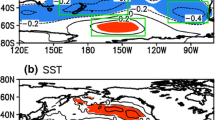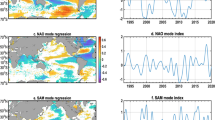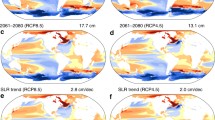Abstract
The atmospheric storminess as inferred from geostrophic wind energy and ocean wave heights have increased in boreal winter over the past half century in the high-latitudes of the northern hemisphere (especially the northeast North Atlantic), and have decreased in more southerly northern latitudes. This study shows that these trend patterns contain a detectable response to anthropogenic and natural forcing combined. The effect of external influence is found to be strongest in the winter hemisphere, that is, in the northern hemisphere in January–March and in the southern hemisphere in July–September. However, the simulated response to anthropogenic and natural forcing combined, which was obtained directly from climate models in the case of geostrophic wind energy and indirectly via an empirical downscaling procedure in the case of ocean wave heights, is significantly weaker than the magnitude of the observed changes in these parameters.






Similar content being viewed by others
References
Alexandersson H, Schmith T, Iden K, Tuomenvirta H (1998) Long-term variations of the storm climate over NW Europe. Glob Atmos Ocean Syst 6:97–120
Alexandersson H, Tuomenvirta H, Schmith T, Iden K (2000) Trends of storms in NW Europe derived form an updated pressure data set. Clim Res 14:71–73
Allan R, Ansell TL (2006) A new globally complete monthly historical mean sea level pressure data set (HadSLP2): 1850–2004. J Clim 19(22):5816–5842
Allen MR, Stott PA (2003) Estimating signal amplitudes in optimal fingerprinting, part I: theory. Clim Dyn 21:477–491
Bacon S, Carter DJT (1991) Wave climate changes in the North Atlantic and North Sea. Int J Climatol 11:545–558
Barnett TP, Pierce D, AchutaRao K, Santer B, Gleicker P (2005) Penetration of human-induced warming into the world’s oceans. Science 309:284–287
Blackmon ML (1976) A climatological spectral study of the 500-mb geopotential height of the Northern Hemisphere. J Atmos Sci 33:1607–1623
Caires S, Sterl A, Komen G, Swail V (2004a) The Web-based KNMI/ERA-40 global wave climatology atlas. WMO Bull 53(2):142–146
Caires S, Sterl A, Bidlot J-R, Graham N, Swail V (2004b) Intercomparison of different wind-wave reanalyses. J Clim 17(10):1893–1913
Cox AT, Swail VR (2001) A global wave hindcast over the period 1958–1997: validation and climate assessment. J Geophys Res 106(C2):2313–2329
Gillett NP, Zwiers FW, Weaver AJ, Stott PA (2003) Detection of human influence on sea-level pressure. Nature 422:292–294
Gillett NP, Allan RJ, Ansell TJ (2005) Detection of external influence on sea level pressure with multi-model ensemble. Geophys Res Lett 32:L19714. doi:10.1029/2005GL023640
Gulev SK, Zolina O, Grigoriev S (2001) Extratropical cyclone variability in the Northern Hemisphere winter from the NCEP/NCAR reanalysis data. Clim Dyn 17:795–809
Hasselmann K (1993) Optimal fingerprint for detection of time dependent climate change. J Clim 6:1957–1971
Hegerl G, Hasselmann K, Cubasch U, Mitchell JFB, Roeckner E, Voss R, Waszkewitz J (1997) On multi-fingerprint detection and attribution of greenhouse gas and aerosol forced climate change. Clim Dyn 13:613–634
Hegerl GC et al (2007) Understanding and attributing climate change. In: Solomon S et al (eds) Climate change 2007: the physical science basis. Contribution of working group I to the fourth assessment report of the intergovernmental panel on climate change. Cambridge University Press, New York, p 944
Hoskins BJ, Hodges KI (2002) New Perspectives on the Northern Hemisphere Winter Storm Tracks. J Atmos Sci 59:1041–1061
IDAG (International ad hoc Dectection and Attribution Group) (2005) Detecting and attributing external influences on the climate system: A review of recent advances. J Clim 18:1291–1314
Jones GS, Tett SFB, Stott PA (2003) Causes of atmospheric temperature change 1960–2000: A combined attribution analysis. Geophys Res Lett 30:1228. doi:10.1029/2002GL016377
Kalnay E et al (1996) The NCEP/NCAR 40-year reanalysis project. Bull Amer Meteor Soc 77:437–471
Kistler R et al (2001) The NCEP-NCAR 50-year reanalysis: monthly means CD-Rom and documentation. Bull Am Meteor Soc 82:247–267
Matulla C, Schoener W, Alexandersson H, von Stroch H, Wang XL (2008) European Storminess: late 19th century to present. Clim Dyn 31:125–130. doi:10.1007/s00382-007-0333-y
Meehl GA et al (2007) Global climate projections. In: Solomon SC et al (eds) limate change 2007: The physical science basis. Contribution of working group I to the fourth assessment report of the intergovernmental panel on climate change. Cambridge University Press, New York, p 944
Nakicenovic N, Swart R (eds) (2000) Special report on emissions scenarios (SRES). Cambridge University Press, New York, p 599
Pettersen S (1956) Weather analysis and forecasting, vol 1, 2nd edn. McGraw-Hill, NY, p 422
Santer BD et al (2003) Contributions of anthropogenic and natural forcing to recent tropopause height changes. Science 301:479–483
Solomon S et al (2007) Climate change 2007: the physical science basis. Contribution of working group I to the fourth assessment report of the intergovernmental panel on climate change. Cambridge University Press, New York, p 944
Stott PA (2003) Attribution of regional-scale temperature changes to anthropogenic and natural causes. Geophys Res Lett 30:1724. doi:10.1029/2003GL017324
Tett SFB, Stott PA, Aleen MR, Ingram W, Mitchell J (1999) Causes of twentieth-century temperature change near the Earth’s surface. Nature 339:569–572
Uppala SM et al (2005) The ERA-40 re-analysis. Q J Roy Meteor Soc 131:2961–3012
Wang XLL, Swail VR (2001) Changes of extreme wave heights in northern hemisphere oceans and related atmospheric circulation regimes. J Clim 14:2204–2221
Wang XLL, Swail VR (2002) Trends of Atlantic wave extremes as simulated in a 40-year wave hindcast using kinematically reanalyzed wind fields. J Clim 15:1020–1035
Wang XLL, Swail VR (2006a) Historical and possible future changes of wave heights in northern hemisphere oceans. Atmosphere Ocean Interactions, vol 2. In: Perrie W (ed) Advances in fluid mechanics Series vol 39, Wessex Institute of Technology Press, Southampton, p 240
Wang XLL, Swail VR (2006b) Climate change signal and uncertainty in projections of ocean wave heights. Clim Dyn 26:109–126. doi:10.1007/s00382-005-0080-x
Wang XLL, Swail VR, Zwiers FW (2006) Climatology and changes of extra-tropical cyclone activity: comparison of ERA-40 with NCEP/NCAR Reanalysis for 1958–2001. J Clim 19:3145–3166. doi:10.1175/JCLI3781.1
WASA Group (1998) Changing waves and storms in the Northeast Atlantic? Bull Am Meteorol Soc 79:741–760
Whitaker LM, Horn LH (1984) Northern Hemisphere extra-tropical cyclone activity for four midseason months. J Climotol 4:297–310
Zhang X, Zwiers FW, Stott PA (2006) Multi-model multi-signal climate change detection at regional scale. J Clim 19:4294–4307
Zhang X, Zwiers FW, Hegerl GC, Lambert FH, Gillett NP, Solomon S, Stott PA, Nozawa T (2007) Detection of human influence on twentieth-century precipitation trends. Nature 448:461–465
Zwiers FW, Zhang X (2003) Towards regional scale climate change detection. J Clim 16:793–797
Acknowledgments
The authors are grateful to Dr. Jiafeng Wang for his help in compiling the climate model outputs, to Dr. Tara Ansell and Dr. Nathan P. Gillett for their help in answering our questions about the HadSLP2 data, and to Dr. Myles Allen for his help in originating the idea of a detection work on ocean wave heights. The authors also wish to thank Dr. Seung-Ki Min and Dr. Bin Yu for their helpful comments on an earlier version of this manuscript.
Author information
Authors and Affiliations
Corresponding author
Appendices
Appendix A Calculation of the atmospheric storminess index G t
The atmospheric storminess index G t is calculated as follows. First, the squared SLP gradient at gridpoint (i, j) is computed as
where P 0 t (i, j) denotes the seasonal mean SLP for gridpoint (i, j) in year t, ϕ j is the latitude of the gridpoint (i, j) and where it is assumed that the grid spacing, in degrees, is equal in both latitude and longitude. Then, the 1961–1990 mean field, \(\bar{G}^0(i,\; j),\) is subsequently calculated for each season and subtracted to obtain anomalies of squared seasonal mean SLP gradients:
The use of the cos(ϕ j ) weighting above accounts for the dependence of the spherical distance between two neighboring gridpoints on the latitude at which both gridpoints are located (for gridpoints on the equator: ϕ j = 0 and cos(ϕ j ) = 1). This computation is performed for each of the 5° × 5° grid boxes analyzed, and for each season and year. The unit for the resulting squared SLP gradient is (hPa)2 per 5° spherical distance.
Appendix B Estimation of internal climate variability
The optimal detection analysis requires knowledge of the internal climate variability. It involves two estimates of the internal variability in this study: \(\hat{C}_{\eta_1}\) and \(\hat{C}_{\eta_2}.\) Both \(\hat{C}_{\eta_1}\) and \(\hat{C}_{\eta_2}\) are climate model based estimates of internal climate variability; both are obtained by pooling the variability of the control simulations together with the inter-integration variability of the twentieth-century simulations (after removing the ensemble mean field from each integration in each of the nine ensembles; see Table 1). However, they are based on two non-overlapping periods of the twentieth-century simulations and two non-overlapping ensembles of control simulations.
More specifically, when analyzing the 1955–2004 (or 1958–2001) trends, \(\hat{C}_{\eta_1}\) is based on the 41 twentieth-century simulations for the period 1955–2004 (or 1958–2001), while \(\hat{C}_{\eta_2}\) is based on the 41 twentieth-century simulations for the period 1900–1949 (or 1900–1943). Accordingly, when analyzing the 1900–1949 trends (see Section 5), \(\hat{C}_{\eta_1}\) is based on the 41 twentieth-century simulations for the period 1900–49, while \(\hat{C}_{\eta_2}\) is based on the 41 twentieth-century simulations for the period 1955–2004. In the mean time, each of the available control simulations (Table 2) is also divided into non-overlapping 50 or 44-year simulation segments, depending upon whether the detection analysis was of a 50-year period (1955–2004 or 1900–1949) or a 44-year period (1958–2001). For example, the ECHO-G 340-year control simulation can be divided into six non-overlapping 50-year simulation segments, corresponding to years 1–50, 51–100,..., and 251–300, respectively (or seven non-overlapping 44-year segments corresponding to 1–44, 45–88,..., and 265–308; see Table 2). As a result, a total of 86 50-year control simulation segments (or 96 44-year segments) were obtained (Table 2). Half of these control simulation segments are used to obtain \(\hat{C}_{\eta_1},\) and the other half, \(\hat{C}_{\eta_2}.\) Thus, combining these with information derived from the 41 twentieth-century simulations, we use a total of 84 (= 86/2 + 41) 50-year simulation segments for the detection analysis on the 1955–2004 or 1900–1949 trend pattern. The degree of freedom here is 74 (= 84−9−1), since nine twentieth-century ensemble-mean trend fields and one control ensemble-mean field (here we pool all control simulation segments used into a single large ensemble because some models have short control simulations) were subtracted from the estimated trend patterns before they are used in the detection analysis. Similarly, for the detection analysis on the 1958–2001 trend pattern, a total of 96 non-overlapping 44-year control simulation segments are used (see Table 2); thus the degree of freedom is 79 (= 96/2 + 41−1−9).
Rights and permissions
About this article
Cite this article
Wang, X.L., Swail, V.R., Zwiers, F.W. et al. Detection of external influence on trends of atmospheric storminess and northern oceans wave heights. Clim Dyn 32, 189–203 (2009). https://doi.org/10.1007/s00382-008-0442-2
Received:
Accepted:
Published:
Issue Date:
DOI: https://doi.org/10.1007/s00382-008-0442-2




